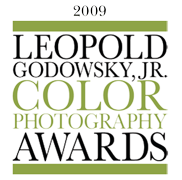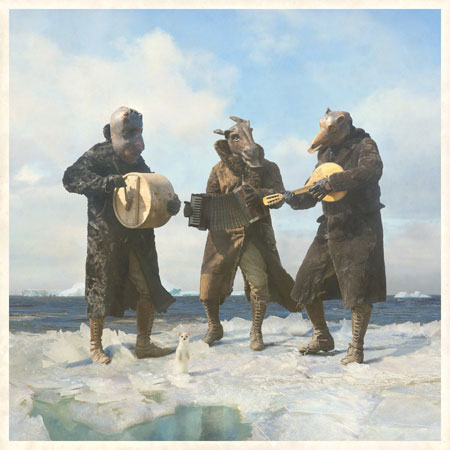


|

|

|
 |
 |
 |
| Nicholas Kahn & Richard Selesnick, Three Musicians, 2008 |

Post Kodachrome? The Future of Color Photography
Unfortunately, Paul Simon's prophetic utterance—"Mama, Don't take my Kodachrome away"— in his 1973 musical hit "Kodachrome" has recently become a reality. On June 22, 2009, Kodak announced that it was ceasing production and sales of all Kodachrome films due to decreased customer demand. The only US processing facility, Dwayne's Photo in Parsons, KS, will continue processing Kodachrome through December 31, 2010.
Kodachrome was one of the longest continuously produced films in the entire history of photography—color or black and white. Much like Polaroid instant film, which ceased production in 2008, Kodachrome continues to inspire intense devotion among image-makers. Generations of photographers and filmmakers have boxes of unexposed film stored away in their freezers and older film can still be bought on eBay.
Further reflecting the exciting evolution of photography since Kodachrome's invention, the definitions of "color" as well as "photograph" have radically changed and the works in this exhibition reflect this shift. A new color canon, which is distinctly international, is emerging. Paradoxically enough, museum departments in photography, painting, and contemporary art are debating which area ought to acquire the larger-format color images. In the wake of the digital revolution, we can only guess what technological developments in color are yet to come.
We invite you to learn more about the evolution of Kodachrome and also explore recent developments at the links below. In addition, please see the timeline, links, and bibliography in the RESOURCES section of this website.
About Leopold Godowsky, Jr. and the Invention of Kodachrome Film
Leopold Godowsky, Jr. (1900–1983) was an accomplished violinist who played with many prominent symphony orchestras. Early in his career, he performed jointly with his father Leopold Godowsky, one of the greatest pianists and composers of the early twentieth century. This strong family connection to the arts continued when Godowsky, Jr. married Frances Gershwin, sister of George and Ira Gershwin, and a vocalist who later became a recognized painter and sculptor. Godowsky, Jr. and Leopold Mannes (1899–1964) discovered common passions in both music and photography while in high school. After seeing an early experimental color movie, the two teenagers set out to "make perfect motion pictures in natural colors." (This search for color began with James Clerk Maxwell's experiments in additive color in the 1860s and accelerated when Auguste and Louis Jean Lumière patented the color Autochrome process in 1903, but a successful solution to a full-color, fine-grained film had not yet been achieved.) While continuing their musical pursuits, Godowsky and Mannes collaborated on color film experiments throughout college, often in hotel and family bathrooms, regularly whistling bars of classical music to measure development time. In the 1920s, Lewis Strauss (later to become Chairman of the US Atomic Energy Commission) helped finance the two researchers. In 1930, Dr. C. E. Kenneth Mees, first director of the Eastman Kodak Research Laboratories, hired Godowsky and Mannes and soon thereafter brought them to Rochester, NY, set them up in a lab, and placed scientists at their disposal in order to accelerate their research.
In 1935, Kodak released Kodachrome 16mm movie film; one year later, they introduced an 8mm version and a still film for then new 35mm cameras. Each of the film's emulsion layers were sensitive to a different color of light, and its fairly simple construction allowed for ease of manufacture. The development of the film, with unique dyes added one at a time and additional processing steps, was very complex; however, it was also extremely stable. (It is worth noting that Kodachrome film is black and white until it is fully processed.) Consequently, after exposure, the film had to be sent back to Kodak to be processed using special equipment, under supervised conditions. Beginning in 1939, the slides were returned to consumers in cardboard mounts that could be projected in recently-invented home slide projectors. Godowsky and Mannes ("God and Man" as they were affectionately known at Kodak laboratories) had become the first to design a system of taking and producing "true color," continuous tone pictures for the mass market. The world, in effect, went from black and white to full color. Suitably, in 2005, both Godowsky and Mannes were inducted into the National Inventors Hall of Fame, a non-profit organization founded in part by the US Patent and Trademark Office.
| CLICK FOR PRINTABLE VERSION WITH FULL LINKS |
SELECTED KODACHROME LINKS (2005 – 2009)
For additional historical and contemporary links compiled for the previous Godowsky Awards, please click here.
Kodak Kodachrome Links
Kodak's Kodachrome Discontinuation NoticeKodachrome Processing
Kodak Press Release, "Kodak Retires KODACHROME Film; Celebrates Life of Oldest Film Icon in its Portfolio"
Kodak Tribute to Kodachrome, slideshow
Kodak blog post, "A Tribute to KODACHROME: A Photography Icon"
Dwayne's Photo, last worldwide Kodachrome processing facilityKodachrome in the News
Kodachrome Project, online forum
Kodachrome To Fade Away, Paul Simon Or No (All Things Considered on NPR)Kodachrome and Color Photography Tributes and Online Collections
Kodak Will Retire Kodachrome, Its Oldest Color Film Stock (NY Times)
Fortune's Kodachrome Legacy (Fortune magazine)
A Brief History of Kodachrome (TIME magazine)
1930-40s in Color Set from Library of Congress's Flickr Commons (Kodachrome)Godowsky and Mannes's Inventor Profiles, National Inventors Hall of Fame
After Polaroid, Keeping Instant Photography Alive (TIME magazine)
FSA/OWI Color Photographs, Library of Congress (Kodachrome)
Kodachrome Culture: The American Tourist in Europe (National Geographic Museum)
Kodachrome 1935-2009 An Appreciation (B&H Photo)
Kodak Retires Kodachrome Film; Celebrates Life of Oldest Film Icon in its Portfolio (Unique Photo)
KODAK KILLS KODACHROME (Adorama Camera)
Ronald Andrews photograph blog, Kodachrome page
Leopold Godowsky, Jr.
Leopold Mannes













